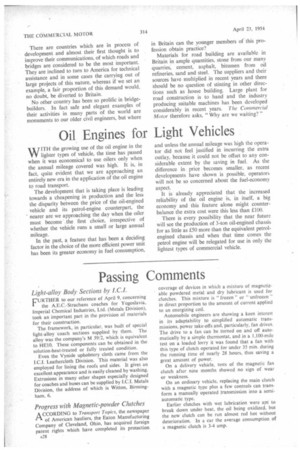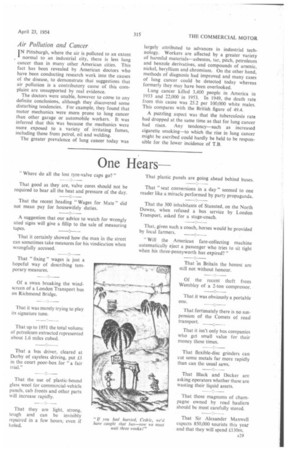Passing Comments
Page 30

Page 31

If you've noticed an error in this article please click here to report it so we can fix it.
Light-alloy Body Sections by I.C.I.
PURTHER to our reference of April 9, concerning
the A.E.C.-Strachans coaches for Yugoslavia, Imperial Chemical Industries, Ltd. (Metals Division), took an important part in the provision of materials for their construction.
The framework, in particular, was built of special light-alloy coach sections supplied by them. The alloy was the company's M 39/2, which is equivalent to HE10. These components can be obtained in the solution-heat-treated or fully treated condition.
Even the Vynide upholstery cloth came from the Leathercloth Division. This material was also employed for lining the roofs and sides. It gives an excellent appearance and is easily cleaned by washing. Extrusions in many other shapes especially designed for coaches and buses can be supplied by I.C.I. Metals Division, the address of which is Witton, Birmingham, 6.
Progress with Magnetic-powder Clutches
ACCORACCORDING to Transport Topics, the newspaper DING American hauliers, the Eaton Manufacturing Company of Cleveland, Ohio, has acquired foreign patent rights which have completed its protection
coverage of devices in which a mixture of magnetizable powdered metal and dry lubricant is used for .clutches. This mixture is " frozen " or " unfrozen " in direct proportion to the amount of current applied to an energizing coil.
Automobile engineers are showing a keen interest in its adaptability to simplified automatic transmissions, power take-offs and, particularly, fan drives. The drive to a fan can be turned on and off automatically by a simple thermostat, and in a 1,100-mile test on a loaded lorry it was found that a fan with this type of clutch operated for under 35 min. during the running time of nearly 28 hours, thus saving a great amount of power.
On a delivery vehicle, tests of the magnetic fan clutch after nine months showed no sign of wear or weakness.
On an ordinary vehicle, replacing the main clutch with a magnetic type plus a few controls can transform a manually operated transmission into a semiautomatic type. Earlier clutches with wet lubrication were apt to break down under heat, the oil being oxidized, but the new clutch can be run almost red hot without deterioration. In a car the average consumption of a magnetic clutch is 3-4 amp.
Air Pollution and Cancer
IN Pittsburgh, where the air is polluted to an extent I normal to an industrial city, there is less lung cancer than in many other American cities. This fact has been revealed by American doctors who have been conducting research work into the causes of the disease, to demonstrate that suggestions that air pollution is a contributory cause of this complaint are unsupported by real evidence.
The doctors were unable, however to come to any definite conclusions, although they discovered some disturbing tendencies. For example, they found that motor mechanics were more prone to lung cancer than other garage or automobile workers. It was inferred that this was because the mechanics were more exposed to a variety of irritating fumes, including those from petrol, oil and welding.
The greater prevalence of lung cancer today was largely attributed to advances in industrial technology. Workers are affected by a greater variety of harmful materials—asbestos, tar, pitch, petroleum and benzoic derivatives, and compounds of arsenic, nickel, beryllium and chromium. On the other hand, methods of diagnosis had improved and many cases of lung cancer could be detected today whereas formerly they may have been overlooked.
Lung cancer killed 3,400 people in America in 1933 and 22,000 in 1953. In 1949, the death rate from this cause was 25.2 per 100,000 white males. This compares with the British figure of 49.4.
A puzzling aspect was that the tuberculosis rate had dropped at the same time as that for lung cancer had risen. Any tendency—such as increased cigarette smoking—to which the rise in lung cancer might be ascribed could hardly be held to be responsible for the lower incidence of T.B.




















































































